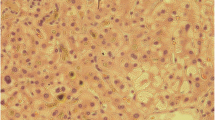Abstract
Purpose of Review
Drug-induced liver injury (DILI) can present with a variable clinical and pathological phenotype and can be classified using liver enzymes as hepatocellular, cholestatic, or a mixed pattern. The cholestatic pattern has been considered amongst the spectrum of direct liver damage at the microscopic level, but recently, bile duct injury, as a manifestation of DILI, has emerged as a distinct entity, and this review examines several examples of biliary tract abnormalities due to DILI from a clinical, radiologic, and pathologic perspective.
Recent Findings
Case series and reports have emerged over the last few years of drugs causing cholangiographic changes or direct injury to the intra- and extra-hepatic biliary tree, such as ketamine and several chemotherapy agents. The DILI Network (DILIN) in the USA has published their experience of cases with vanishing bile duct syndrome on histology and sclerosing cholangitis-like changes seen on cholangiography. The pathogenesis of these changes is unclear but it appears that this type of injury is more severe and more likely to lead to a chronic injury with increased mortality than other cases of DILI.
Summary
Bile duct injury due to DILI is an increasingly recognized entity and imaging of the biliary tree in conjunction with liver biopsy should be considered in patients with severe cholestatic DILI.

Similar content being viewed by others
Abbreviations
- ALT:
-
Alanine aminotransferase
- Alk P:
-
Alkaline phosphatase
- AST:
-
Aspartate aminotransferase
- DILI:
-
Drug-induced liver injury
- DILIN:
-
Drug-Induced Liver Injury Network
- MRCP:
-
Magnetic resonance cholangiopancreatography
- SC:
-
Sclerosing cholangitis
- VBDS:
-
Vanishing bile duct syndrome
References
Papers of particular interest, published recently, have been highlighted as: • Of importance •• Of major importance
Chalasani N, Björnsson E. Risk factors for idiosyncratic drug-induced liver injury. Gastroenterology. 2010;138:2246–59.
Björnsson E. Review article: drug-induced liver injury in clinical practice. Aliment Pharmacol Ther. 2010;32:3–13.
Kleiner DE, Chalasani NP, Lee WM, Fontana RJ, Bonkovsky HL, Watkins PB, et al. Hepatic histological findings in suspected drug-induced liver injury: systematic evaluation and clinical associations. Hepatology. 2014;59:661–70.
•• Bonkovsky HL, Kleiner DE, Gu J, Odin JA, Russo MW, Navarro VM, et al. Clinical presentations and outcomes of bile duct loss caused by drugs and herbal and dietary supplements. Hepatology. 2017;65:1267–77 Important clinical and histopathologic description of drug induced vanishing bile duct syndrome and its relatively poor prognosis.
Gudnason HO, Bjornsson HK, Gardarsdottir M, Thorisson HM, Olafsson S, Bergmann OM, et al. Secondary sclerosing cholangitis in patients with drug-induced liver injury. Dig Liv Dis. 2015;47:502–7.
•• Ahmad J, Rossi S, Rodgers SK, Ghabril M, Fontana RJ, Stolz A, et al. Sclerosing cholangitis-like changes on magnetic resonance cholangiography in patients with drug induced liver injury. Clin Gastroenterol Hepatol. 2019;17:789–90 First study to look at drug-induced sclerosing cholangitis using two expert MRCP readings of MRCP done blinded to clinical data.
Chalasani N, Bonkovsky HL, Fontana R, Lee W, Stolz A, Talwalkar J, et al. Features and outcomes of 899 patients with drug-induced liver injury: the DILIN prospective study. Gastroenterology. 2015;148:1340–52.
Phongkitkarun S, Kobayashi S, Varavithya V, Huang X, Curley SA, Charnsangavej C. Bile duct complications of hepatic arterial infusion chemotherapy evaluated by helical CT. Clin Radiol. 2005;60:700–9.
Sandrasegaran K, Alazmi WM, Tann M, Fogel EL, McHenry L, Lehman GA. Chemotherapy-induced sclerosing cholangitis. Clin Radiol. 2006;61:670–8.
Horsley-Silva JL, Dow EN, Menias CO, Smith ML, Carballido EM, Lindor KD, et al. Docetaxel induced sclerosing cholangitis. Dig Dis Sci. 2015;60:3814–6.
Wong GL, Tam YH, Ng CF, Chan AW, Choi PC, Chu WC, et al. Liver injury is common among chronic abusers of ketamine. Clin Gastroenterol Hepatol. 2014;12:1759–62.
• Seto WK, Mak SK, Chiu K, Vardhanabhuti V, Wong HF, Leong HT, et al. Magnetic resonance cholangiogram patterns and clinical profiles of ketamine-related cholangiopathy in drug users. J Hepatol. 2018;69:121–8 Includes well-documented cases of ketamine cholangiopathy with cases of resolution after drug discontinuance.
Seto WK, Ng M, Chan P, Ng IO, Cheung SC, Hung IF, et al. Ketamine-induced cholangiopathy: a case report. Am J Gastroenterol. 2011;106:1004–5.
Turkish A, Luo JJ, Lefkowitch JH. Ketamine abuse, biliary tract disease, and secondary sclerosing cholangitis. Hepatology. 2013;58:825–7.
Parola M, Cheeseman KH, Biocca ME, Dianzani MU, Slater TF. Biochemical studies on bile duct epithelial cells isolated from rat liver. J Hepatol. 1990;10:341–5.
Lakehal F, Wendum D, Barbu V, Becquemont L, Poupon R, Balladur P, et al. Phase I and phase II drug metabolizing enzymes are expressed and heterogeneously distributed in the biliary epithelium. Hepatology. 1999;30:1498–506.
O'Brien CB, Shields DS, Saul SH, Reddy KR. Drug-induced vanishing bile duct syndrome: response to ursodiol. Am J Gastroenterol. 1996;91:1456–7.
Jakab SS, West AB, Meighan DM, Brown RS Jr, Hale WB. Mycophenolate mofetil for drug-induced vanishing bile duct syndrome. World J Gastroenterol. 2007;13:6087–9.
Kawasaki Y, Matsubara K, Hashimoto K, Tanigawa K, Kage M, Iwata A, et al. Nonsteroidal anti-inflammatory drug-induced vanishing bile duct syndrome treated with plasmapheresis. J Pediatr Gastroenterol Nutr. 2013;57:e30–1.
Kwo PY, Cohen SM, Lim JK. ACG clinical guideline: evaluation of abnormal liver chemistries. Am J Gastroenterol. 2017;112:18–35.
Lalani T, Couto CA, Rosen MP, Baker ME, Blake MA, Cash BD, et al. ACR appropriateness criteria jaundice. J Am Coll Radiol. 2013;10:402–9.
Author information
Authors and Affiliations
Contributions
All authors contributed to the collection of clinical data, data analysis, and initial and final drafting of the manuscript.
Corresponding author
Ethics declarations
Conflict of Interest
Priya Grewal and Jawad Ahmad each declare no potential conflicts of interest.
Human and Animal Rights and Informed Consent
This article does not contain any studies with human or animal subjects performed by any of the authors.
Additional information
Publisher’s Note
Springer Nature remains neutral with regard to jurisdictional claims in published maps and institutional affiliations.
This article is part of the Topical Collection on Drug Induced Liver Injury
Rights and permissions
About this article
Cite this article
Grewal, P., Ahmad, J. Bile Duct Injury Due to Drug-Induced Liver Injury. Curr Hepatology Rep 18, 269–273 (2019). https://doi.org/10.1007/s11901-019-00474-0
Published:
Issue Date:
DOI: https://doi.org/10.1007/s11901-019-00474-0




